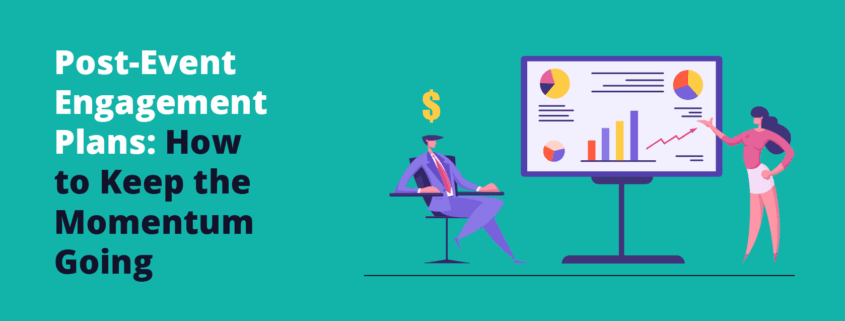Post-Event Engagement Plans: How to Keep the Momentum Going
Did you know that hybrid events can increase revenue by up to 15% for organizers? Or that 81% of U.S. donors attend nonprofit fundraising events each year?
That’s a massive opportunity for nonprofits to boost revenue and engagement, but only if you know what to do after the attendees go home and the tables are cleared.
Considering all the planning that goes into your fundraiser, from choosing a venue to securing sponsorships, it’s easy to look at the end of the event as a finish line. However, it’s actually a starting line for long-term relationships, and your post-event strategy is what truly converts a one-time attendee into a long-term donor.
There’s a three-stage framework you can follow to keep your momentum strong: Connect, Share, and Invite. Let’s break it down.
Connect With Attendees Through Personalized Gratitude
The clock starts the moment your event ends. The most effective follow-up happens within 24 to 48 hours, and it starts with a heartfelt “thank you.”
Send a short, personalized email or letter that addresses recipients by name and acknowledges their specific role, whether they attended, volunteered, donated, or sponsored. Sincere appreciation sets the tone for ongoing engagement.
According to CharityEngine, event software can streamline this follow-up through features, such as:
- Attendee communication tools: Automate personalized thank-yous and follow-ups using pre-tagged lists of attendees, donors, and volunteers, ensuring no one is forgotten. If you use event management tools integrated into your nonprofit’s CRM, you’ll ensure that your communications include all the relevant data for the recipient.
- Reporting and analytics: Evaluate the event’s performance, including detailed data on individual guests’ participation. That way, you can send personalized messages that recognize each attendee’s unique interaction with the event! For example, you might thank James for participating in the raffle games, but share with Jackie how impactful her non-cash donation was.
- Guest portals: Provide attendees with access to post-event materials, including receipts, donation summaries, and upcoming opportunities, all in one convenient location.
Add a short highlight reel or photo gallery to your message to enhance its visual appeal. Let your attendees relive the magic and reinforce the positive emotions tied to your mission.
Share Your Mission and Impact Story
After your thank-yous are sent, shift the focus from the event to your impact. You’re now moving from gratitude to storytelling and stewardship.
Your post-event communications should include:
- Impact data: Use data analytics to calculate meaningful metrics that connect your event and impact data. For example, calculate the amount your organization raised through the event, how much was spent on a particular program, and that program’s reach in terms of the number of beneficiaries served.
- Repurposed event content: Turn your event into ongoing content that reinforces the learning or emotional takeaways. This could be a blog post summarizing the keynote speaker’s key points, a photo gallery, or a link to a recorded session.
- Personalized storytelling: To effectively steward relationships with donors, your nonprofit should share information that resonates most with them. Segment event attendees based on their actions, motivations, and any other information stored in your database. Then, share stories from volunteers or beneficiaries that most align with attendees’ interests.
Finally, send a short, focused post-event survey (no more than 10 questions). Ask what resonated most, what could be improved, and whether they’d like to be more involved. This shows you value their opinion, and it gives you data to make your next event even stronger.
Invite Donors to Deeper Involvement
Now that your audience feels connected and informed, it’s time to invite them further into your mission. Resist the urge to jump straight to another donation request! Many have likely already contributed through tickets or gifts.
Instead, offer low-friction engagement opportunities that build loyalty:
- Exclusive learning: Certain events, such as conferences or professional development workshops, are sources of revenue for your organization and conducive to providing exclusive, on-demand content. Implement a learning management system (LMS) to host recorded keynotes, presentation slide decks, and bonus materials that attendees can access after the event concludes.
- One-on-one engagement: According to BWF, events are a great opportunity to meet face-to-face with your donors and set up times for one-on-one engagement with them. Offer VIP Q&As with your board, coffee chats with your executive director, or behind-the-scenes tours of your programs.
- Branded merchandise: When event attendees purchase items through your nonprofit’s online store, they don’t feel like they’re making a donation, because they’re receiving something in return. Your inventory could include branded merchandise, such as t-shirts and mugs, that will also turn event attendees into brand ambassadors after your fundraiser concludes.
Each follow-up should include a clear call to action (CTA)—join a volunteer team, subscribe to your monthly giving program, or register for the next event. Keep it simple, specific, and easy to act on.
The event itself may end in one night, but the momentum you build afterward determines your long-term success. Post-event engagement is the real engine of ROI; it’s the disciplined, personalized, and strategic follow-up that transforms fleeting excitement into lasting loyalty.
So, the next time you’re wrapping up a big fundraiser, remember: this isn’t the end. It’s the beginning of a deeper connection between your supporters and your mission.

